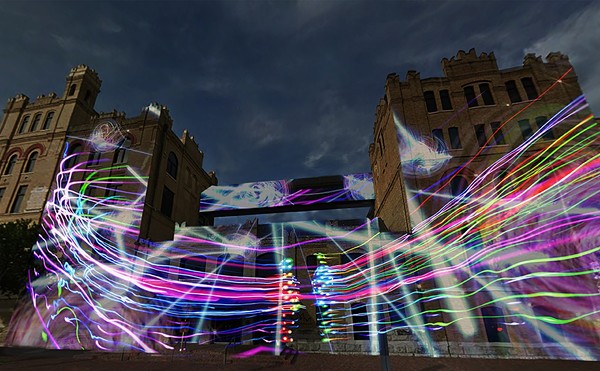A concrete crater remains where seats have been stripped away in the belly of the old Municipal Auditorium; the room is cavernous, like an old rock quarry. For now, the hulking stage that has hosted concerts, boxing matches, and high school graduations since the auditorium was built in 1926 still stands. But it too will fall as construction continues to radically reconfigure this city landmark into the Tobin Center for the Performing Arts, a new home for San Antonio’s symphony, ballet, and opera.
As recent attempts to halt the project, originally made possible by a $100-million county bond election in 2008, have floundered in the courts, architect’s renderings of the new center have appeared in the press. The most prominent shows the Municipal Auditorium’s Spanish Colonial Revival columned front façade, surmounted by a towering box-like eruption that reminds us of the veiled Ka’aba in Mecca. But what will the interior be like, how much of the original building will be saved, and why was this particular design chosen?
I sought to answer those questions by joining J. Bruce Bugg, Jr., chairman and president of the Bexar County Performing Arts Center Foundation, at the construction site last week. Decked out in hard hats, reflective vests, and goggles, the two of us looked like poster kids for OSHA as we entered the building. Peering out into the immense empty space, Bugg recalled a comment that captures the experience of being in the hole. “When I brought Tommy Lee Jones here the first time, he asked me, ‘Bruce, what are you going to do with this airplane hanger?’”
Jones, along with a host of local notables, including Peter Holt and Tom Frost III, is on the Foundation’s board of directors helping guide its development. But Bugg also heads up the Tobin Endowment, a grant-making institution that won naming rights to the performing arts center when they made the first bequest of $15 million to the project. Before being asked in 2007 to form and lead the foundation that will manage the center by then-Mayor Phil Hardberger and Bexar County Judge Nelson Wolff, Bugg served as the vice chairman of the capital campaign at the McNay Art Museum, raising $50.8 million for the Jane and Arthur Stieren Center for Exhibitions, the new wing that opened in 2008.
As we walked through the construction site, he recalled the history of the old building. Originally built as a memorial to WWI veterans, the Municipal Auditorium served as the city’s main location for events until Freeman Coliseum was built in 1949. The auditorium was gutted by fire in 1979, losing its distinctive domed roof. But it reopened six years later after a massive restoration effort.
Entering from the side of the auditorium, we walked to the front where sections of the building survived the ’79 fire, including the original lobby (more like a foyer), and the round copulas on each side. In today’s transformation, both are being preserved. Also being kept intact are the walls that arc along each side of the original front, though the old stage house in back will be demolished to accommodate the improvements. Blocks have been removed from the façade to allow reinforcement of the walls. They sit in stacked rows, numbered to ensure their proper reintegration. A new lobby will occupy the space behind the original interior wall. It will be a center for socializing during intermissions and after concerts, and provide a location for community events.
Within the looming box-like addition that will rise behind the front of the old Municipal Auditorium, not one, but two theaters will be built. The largest will hold 1,761 seats, plus 27 boxes in a concert hall with a proscenium stage that will be capable of presenting an orchestra of 100 musicians. This hall will also be ideal for the ballet, the opera, and other large performing arts groups such as Mariachi Vargas Extravaganza. The second performance space is a studio theater with a huge glass wall opening onto the river. It will have room for approximately 250 seats, and will be used for smaller groups, serving not only as an intimate space for solo performance and chamber music, but for experimental theater and dance, educational programs, and as an incubator space for upcoming performing arts organizations as well. The studio theater will be able, like many black-box theaters, to accommodate a variety of staging arrangements. Currently, 41 organizations are being considered as resident companies for both spaces, including Mariachi Vargas, The Attic Repertory, the Youth Orchestras of San Antonio, and the Children’s Chorus of San Antonio, according to Bud Franks, the interim managing director of the Tobin Center project.
The the main hall will also be incredibly flexible. Concert halls are designed with seats set in ascending rows so that audience members can see above those in front. An innovation to the main concert hall includes a motorized mechanism able to convert the traditional raked seating to multi-tiered cabaret configuration, or to a flat floor set at the same elevation as the stage, or below it, with stage intact. Though not part of the original plans, nor mandated by the art center’s agreement with the county, “We decided at an additional cost of eleven million dollars to put in what’s called a ‘flat floor seating system,’” Bugg said. “We can, at the push of a button and in 15 minutes, collapse all the rake seating and you can’t tell it by looking at the chairs.”
Jack Fishman, president of the San Antonio Symphony Orchestra, began as a double-bass player. Now the symphony’s managing operator, he still has a keen ear and understanding of the mechanics of sound. He explained the difficulties the symphony encounters performing at their current headquarters, the Majestic Theatre downtown.
“The Majestic was designed for silent movies,” Fishman said, “and let me emphasize the word ‘silent.’ It has been remodeled, and it works quite well for amplified music, where you can add reverb. But I would guess that people coming to our concerts are missing out on a significant portion of the impact. It is still a pleasant concert experience, but it doesn’t have that ‘oomph’ hit you in the chest, excitement that a great concert hall provides.”
Fishman called LMN Architects, and the sound specialist firm Akustiks, “some of the best in the world.” They are building the Tobin Center, along with local firm Marmon Mok, The Projects Group, and specialist companies such as Fisher Heck, which has overseen the historic site aspects of the renovations. LMN are the designers of the Seattle Symphony’s Benaroya Hall and McCaw Hall, home to Seattle Opera and Pacific Northwest Ballet. Akustiks is responsible for the acoustical design of the Schermerhorn Symphony Center in Nashville, “one of the best concert halls built in America” Fishman said. “The Tobin Center will start with a reverb time of at least 2.2 seconds.”
Fishman said that a long reverb, or sustain, is necessary for natural acoustic (un-amplified) music like symphonic orchestra and opera. But each is performed best in a hall with slightly different acoustics. To accommodate performing groups with varying acoustic needs, movable devices, like curtains, and other baffles, can be put in place to deaden the sound. By contrast, New York’s famed Carnegie Hall has a reverb clocked at 1.7 seconds.
Fishman is also ecstatic about the movable floor being installed at the Main Hall. “What if the symphony played the first half of a concert with music that was influenced by the waltz, like the Rosenkavalier (a comic opera by Richard Strauss),” he proposed. “Then the audience went out at intermission, had a drink, and when they came back all their seats were gone, and you could dance to the waltz. If I had to sum up in a phrase what I would call this opportunity, it is ‘club symphony.’”
Mark Reddington, a principal of LMN Architects, said his team was charged with “providing a state-of-the-art performing arts facility, an opportunity for diverse community users, and active educational opportunities within the building.” Functionality, both in acoustics and in the social sense, dominated design decisions. Reddington, speaking on the phone from Seattle, emphasized that though the movable floor was not part of the original ambition for the project, it will be “a terrific amenity for the community,” making the facility usable for a greater variety of events.
But not everything is happening inside. Another performance area is planned for outside that will be set into an incline rising from the river next to the Carlos Cortes sculpture now sitting under a high wall. Sloping up from the River Walk, the River Plaza will reclaim the riverfront with grass, trees, and event space. The pleasant green space will encourage foot traffic from the river up to street level, enhanced by the stunning visual improvement over the old stage house that now hulks over the river. “Of course the original building was constructed before the River Walk existed,” Reddington said. Before the river was opened up, it was just a source of irregular, unpredictable flooding, the dirty back alley of the city. “So now,” Reddington continued, “instead of having a front and a back, the center will have two fronts — facing into the city, and onto the river — in an inviting way.”
With the extension of the River Walk into the so-called Museum Reach in May of 2009, the Municipal Auditorium entered a new era. Consider the 1,000-capacity outdoor amphitheatre rising from the river’s edge behind the Pearl Brewery complex. In similar fashion, a green slope will rise from the waters to the Tobin. And don’t expect to see the property choked riverside by competing development. The river’s main function here is still largely flood control, as opposed to the older River Walk loop, a massive flood-control project turned commercial corridor designed by architect Robert H. H. Hugman after the flood of 1921 took 50 lives. “As far as having restaurants and hotel entrances and shops immediately at the river’s edge, on the Museum Reach stretch of the river that’s not going to be possible,” said Steve Schauer, spokesman for the San Antonio River Authority. “It still has to function as flood control. There will always be a slightly different feel from the Hugman-era river loop in the center of our town; that area can be closed off with a couple of gates and protected during flood events.”
A walk north on the river from the Lexington Avenue entrance across from the Municipal Auditorium becomes ever greener as it leads quickly to the San Antonio Museum of Art. Driving between the two edifices of culture demands a dizzying, typically SA, number of turns. But the walk up the river shortens the distance, creating a new mental map of the city. The café at SAMA, Schauer said, was added when the Museum Reach brought another path to the museum. Minutes away again on foot from SAMA, one reaches the Pearl. While the restaurant and hotel-lined old river loop seem to bring the city onto the water, here one feels that it is the river that leads up to the city — quite a different thing.
Schauer explained that the amphitheatre at the Pearl is designed as part of the water containment system. “In the event of heavy rains, as water rises in that area — as it potentially can and will — you’re not going to see damage to infrastructure.” The rising banks at the Tobin Center will have to function the same way.
The Museum Reach stretch of the river has escaped the theme park in the center of town, seeming to embody what architect Effie Bouras called for as a remedy to the follies of “plug and play type urban planning,” in her 2010 study, Landscape Urbanism: Building as process and the practice of indeterminism. Restored as both greenbelt and pathway, the river opens our eyes to the future of the city with “a mutant logic that engulfs … all realms of urban complication.” As the potential interdependence between what will be the Tobin Center and SAMA become obvious during a river walk, other connections appear when walking up to the Municipal Auditorium site from the water. A few blocks to the west is the Southwest School of Art, and beyond that but still in the downtown area, is Artpace. Almost hidden from the imagination but in plain view lie the hubs of an urban cultural district, difficult to picture in the mind when driving, but clearly visible after walking the river.
John Toohey, director of Arts San Antonio, a nonprofit that coordinates placement of performing arts at local venues, sees great potential for the Tobin Center. “I think that the new hall, with more modest seating capacity than the Lila Cockrell (at the SA Convention Center), the Majestic Theatre, or Laurie Auditorium at Trinity University, will translate into a more intimate and powerful experience for the audience. It will provide a power and quality of experience that is not available for symphony patrons now.
“There are small acoustically wonderful venues in SA currently, but they don’t work well for symphony concerts,” he added. “Ruth Taylor [Recital] Hall at Trinity University is wonderful, but it barely accommodates three hundred people, and the stage is kind of small.” Travis Park United Methodist Church was home to a classical guitar festival and “you could hear every note with no amplification,” Toohey said. But it is, after all, a church with limited space for performers. While the Laurie Auditorium does have admirable acoustics, it is heavily utilized by Trinity University.
One of the ways a city is judged is whether its major performing arts organizations are provided with a base, a home to practice in, and a location in which the audience can find the company when it is not on tour. Many cities, like Seattle, have both a symphony hall and a home for opera and ballet. As expensive as the project is, we just might be getting off cheap when the multiple-venue alternative is considered.
Is everybody happy? No. Construction at the site continues after a motion filed by Sharyll Teneyuca and Placido Salazar to grant a temporary restraining order to halt work was turned down a second time by State District Judge Victor Negrón on July 5. Teneyuca, an attorney and author who is the niece of 1930s labor organizer Emma Tenayuca, may appeal. One of the most colorful stories about the Municipal Auditorium is how, during a 1939 speech by Tenayuca, she and other members of the National Workers’ Alliance were forced to escape through a secret passageway at the Auditorium when they were attacked by a mob in what is considered the worst race riot in the city’s history.
The suit followed a year and a half of controversy, during which the San Antonio Conservation Society voiced concerns that alterations to the building — which will include demolition of its domed roof and proscenium stage — will irreparably destroy the profile of the structure, which is listed on the National Register of Historic Places. “We did work diligently the last 16 months on this project,” the Conservation Society’s new president, Nancy Avellar, told the Current recently. “There was a lot of consternation and displeasure on the part of the board — we did make a statement opposing any demolition. But at this time we do appreciate their efforts to save the most visible and well-known parts of the Municipal Auditorium.” Perhaps gallant in defeat, the Conservation Society’s well-informed concerns are paralleled by public confusion about the details of the project.
The BCPACF will own and be responsible for managing the Tobin Center with no future funds (above the 2008 $100 million bond) available from the county. The City of San Antonio has donated the Municipal Auditorium, the firehouse, and land on the river to the foundation. Bugg said the additional $11 million for the mechanical floor has been added to an original task of raising $20 million, but that the final funding target for BCPACF has been increased to $54 million, which will include an endowment for the foundation and operating funds “to change out the seats, the upholstery in five years, you know things like that.” To date, $33 million has been raised. “A lot of projects get built and then you don’t have any money for keeping it,” Bugg said.
For Bugg, the Tobin is not just about entertainment, but about San Antonio’s young people being able to enter the future with confidence — and skills. “Children that are exposed to the arts, it’s been proven, have higher math, science, and reading skills. This is not a luxury; we need art. The dropout rate among our high schools in San Antonio, it’s ridiculous.”
By the time the doors open and San Antonio meets its new cultural destination, Bugg wants everybody in the community to feel ownership in the project. “I want everybody to be able to complete the sentence,” Bugg insists, “This performance arts center is relevant to me because … ” •
Acoustic Alchemy
A rundown of SA’s current performance houses
Tobin Center for the Performing Arts
100 Auditorium Circle, Main Hall will seat 1,761; Studio Theatre will seat up to 250
Acoustics: 5 stars (we hope)
Laurie Auditorium
One Trinity Place at Trinity University, seats 2,700
Acoustics: 4 stars
The Vienna Boys Choir is reputed to have cheated with aid of “modest amplification.”
Ruth Taylor Recital Hall
One Trinity Place at Trinity University, seats 320
Acoustics: 4 stars
Pianos shouldn’t be amplified. Here, they aren’t.
Lila Cockrell Theatre
200 E Market at SA Convention Center, seats 2,300
Acoustics: 3 1/2 stars
Good place for a convention, or musical theatre.
Majestic Theatre
224 E Houston, seats 2,300
Acoustics: 2 1/2 stars
Built in 1929 as a movie theater, it is one of the most dramatically “atmospheric” halls in the country.
Charline McCombs Empire Theatre
226 N Saint Mary’s, seats 850
Acoustics: 3 1/2 stars
Built in 1913 and damaged by the 1921 flood, much of its gold-leaf interior was covered in white paint until 1990s restoration. Reopened in 1998.
Carver Community Cultural Center,
Jo Long Theatre
226 N Hackberry, seats 650
Acoustics: 3 stars
This important Eastside venue is a good place to see dance and theatrical performance.
Travis Park United Methodist Church
230 E Travis, seats 1,400
Acoustics: 4 1/2 stars
Great sounds, but keep the group small. Quartets work fine.
















